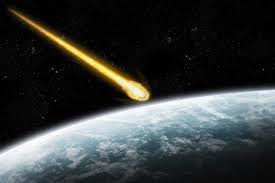Its passage has kept astronomers busy for months now. Asteroid passing earth but 1998 qe2 asteroid not hitting earth
1998 QE2 is passing through earth right now at a very fast and furious speed. Though many people may be fearing it, but thankfully it is not hitting earth. The steroid is really very huge and would have destroyed almost the whole earth if it would have hit the earth, but it is just flying by without no fear of hitting it. There are reports that this monster asteroid is dragging is moon along with it too.
The asteroid was discovered decades ago and they had fixed the date of the flyby for today and indeed it is flying by now. For the last so many years the astronomers are awaiting its arrival and for months the wait started showing their toll when the time looked like having stopped due to the long wait they endured.
Though the astronomers and NASA had kept a close watch on the asteroid, but it was only just days ago when they discovered that the star was being accompanied by its own moon. For the last several days NASA has been tracking it with radar devices since Thursday, not to clock its speed but to get good pictures of it. It was merely yesterday when they discovered its moon. A senior NASA official says, “It turns out that 1998 QE2 is a binary asteroid…This is something we did not expect”.
The asteroid is passing through by a difference of millions of miles. According to the calculations drawn by the researchers, it is being expected that the space rock will come within 3.6 million miles (5.8 million km) of our planet — about 15 times the distance separating Earth and the moon. , researchers say. But this distance would be a visual treat to the astronomers, who plan to get a good look at 1998 QE2 using two huge radar telescopes — NASA’s 230-foot (70 meters) Goldstone dish in California and the 1,000-foot (305 m) Arecibo Observatory in Puerto Rico.
Several NASA officials are looking very excited like other astronomers. Talking about the dramatic event, Lance Benner of NASA’s Jet Propulsion Laboratory in Pasadena, Calif., principal investigator for Goldstone radar observations, said in a statement: “Whenever an asteroid approaches this closely, it provides an important scientific opportunity to study it in detail to understand its size, shape, rotation, surface features and what they can tell us about its origin We will also use new radar measurements of the asteroid’s distance and velocity to improve our calculation of its orbit and compute its motion farther into the future than we could otherwise. It is not the first time that Asteroid 1998 QE2 has come across the space observers. It had its first rendezvous with the earthlings when it was discovered in August 1998 by astronomers working with MIT’s Lincoln Near Earth Asteroid Research (LINEAR) program in New Mexico.
The asteroids have always fascinated the astronomers and even laymen. The nickname has been assigned by the Minor Planet Center in Cambridge, Mass., which names each newfound asteroid according to an established alphanumeric scheme that lays out when it was discovered. Astronomers plan to study 1998 QE2 intensively from May 30 through June 9, using the Goldstone and Arecibo dishes to learn as much as possible about the asteroid before it slips off once more into the depths of space. Even from about 4 million miles (6.4 million kilometers) away, Goldstone images may be able to resolve features on 1998 QE2 as small as 12 feet (3.75 meters) across, researchers said.
Even top astronomers are failing to hide the excitement regarding the asteroid. “It is tremendously exciting to see detailed images of this asteroid for the first time,” With radar we can transform an object from a point of light into a small world with its own unique set of characteristics. In a real sense, radar imaging of near-Earth asteroids is a fundamental form of exploring a whole class of solar system objects,” Benner said. It is pertinent to mention here that NASA has been leading the global effort to identify potentially dangerous asteroids as our planet is prone to the asteroid strike. It has been hit by space rocks throughout its 4.5-billion-year history. In fact on February 15, a 55-foot (17-m) object exploded without warning over Russia, just hours before the 130-foot asteroid 2012 DA14 gave Earth a close shave, missing our planet by just 17,200 miles (27,000 km).
shareshareshareshare

